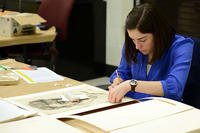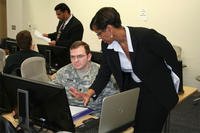Do you want to break into the medical transcription career? This field is ideal for a military spouse because it allows for professional growth no matter where you are in the United States - most positions are portable!
If this sounds like the job for you, here are a few common questions a prospective medical transcriptionist might have:
Related: Does your resume pass the 6-second test? Get a FREE assessment.
Q. How long will it take me to become a medical transcriptionist?
AAMT's Model Curriculum for Medical Transcription, used by educators in developing their programs, recommends a two-year program that includes an externship program or simulated professional practice setting, emphasizing a variety of healthcare documents. Some schools offer shorter programs. However, medical transcription is a medical language and healthcare documentation specialty, not a keyboarding specialty, and intensive study is needed to acquire a high level of fluency in the medical language. Remember, you are gaining knowledge that will translate into a lifetime career!
Q. Where can I learn medical transcription?
Programs that teach medical transcription can be found in community colleges, proprietary schools, and vocational-technical schools. There are also a number of online home-study programs which can be found by doing an Internet search.
AAMT advises that you look for programs that allow for interaction between instructors and students and provide opportunities for networking among students. Many classroom and online programs include this feature. This will better prepare you for the real world of medical transcription and for getting your first job in the field.
Related: The Military Spouse Employment Manual
AAMT's companion paper, Choosing An MT School, is designed to assist you in evaluating any programs you may be considering. We recommend that you look for programs that emphasize excellence in transcription, rather than focusing their advertising on medical transcription as a work-at-home opportunity. While it may be possible for you to do medical transcription from your home, the desire to work at home should not be your primary reason for entering this profession.
We advise you to carefully evaluate claims or promises made to you by any school with regard to future employability or job placement assistance.
Q. Does AAMT accredit medical transcription programs?
In the fall of 2005, the Approval Committee for Certificate Programs, a joint committee established by AAMT and AHIMA (American Health Information Management Association), established an approval process for medical transcription education programs whose curriculum conforms to the AAMT Model Curriculum.:
Each approved school has demonstrated excellence in its program and has established a strong record of job placement for its graduates through its contacts with employers in the industry.
The names of additional approved programs will be added to this list and published on the AAMT web site as approval is granted.
Q. I have already been trained in another medical field. Why do I need further training?
Learning how to listen with discrimination requires practice and guidance from an experienced medical transcription instructor. If you already have the requisite keyboard skills, the additional courses you need will include many hours of transcribing practice. You probably have a head start, but you will need to learn how to integrate your medical knowledge with keyboarding and listening skills.
Q. Does AAMT provide a medical transcription course?
AAMT is the membership organization for the medical transcription profession. We do not administer educational programs. However, we have developed the Model Curriculum for Medical Transcription, now in its 3rd edition, which educators use in developing educational programs. We also offer audio tapes and CDs for use in the classroom and for independent study. In addition, The AAMT Book of Style for Medical Transcription, now in its 2nd edition, is considered the gold standard in the industry.
Q. Will I be a certified medical transcriptionist (CMT) when I finish school?
While completion of a medical transcription course may entitle you to a diploma or a certificate of completion from the school you attend, this is not equivalent to the recognized professional designation of Certified Medical Transcriptionist (CMT). This certification can be achieved only by passing the certification examination administered by AAMT. Only medical transcriptionists with at least two years of experience in acute-care transcription are considered qualified to sit for the certification exam.
To retain the credential, a CMT must meet recertification requirements that include continuing education.
Q. Why should I become certified?
While you are not currently required to become a CMT in order to work as a medical transcriptionist, earning the credential demonstrates to employers and peers that you are a professional and committed to being the best you can be. Certification also serves the public interest by assuring that those who become certified have met accepted standards of practice. Certification elevates the profession as well as the individual.
Many employers prefer to hire-and pay a premium for-CMTs, and many require the credential for career advancement.
Related: For the latest veteran jobs postings around the country, visit the Military.com Job Search section.
Looking for more job tips?
Sign up for a free Military.com membership to have military news, updates and job resources delivered directly to your inbox.























